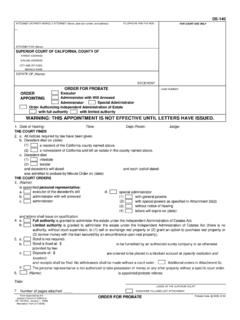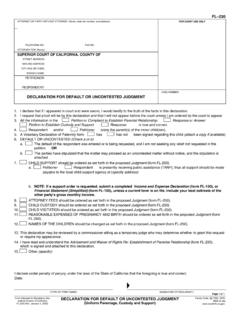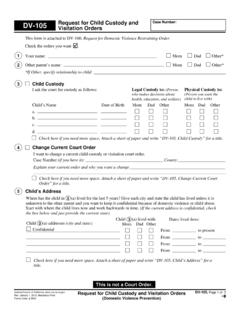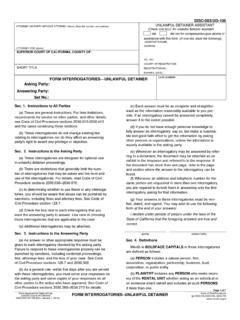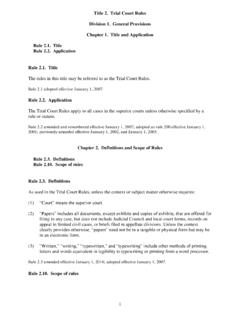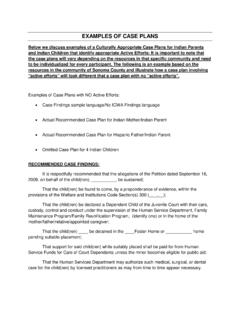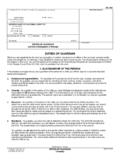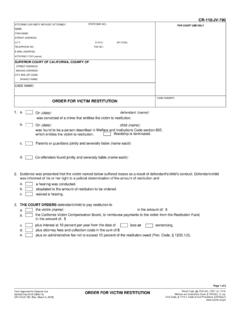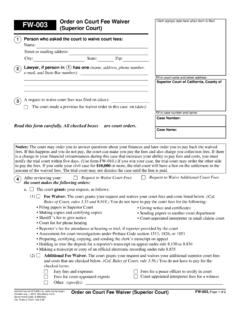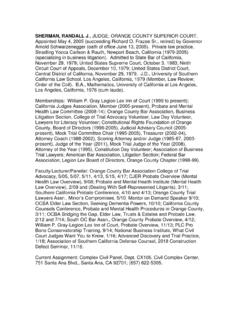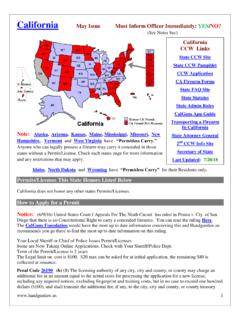Transcription of California Judicial Branch - California Courts - Home
1 California Judicial Branch Page 1 of 5. FACT SHEET. Judicial COUNCIL. OF California February 2018. 455 Golden Gate Avenue San Francisco, CA. 94102-3688 California Judicial Branch Tel 415-865-4200. TDD 415-865-4272. Fax 415-865-4205. The California court system the largest in the nation, with approximately 2,000 Judicial officers and more than 6 million cases serves more than 39. million people. The state Constitution vests the Judicial power of California in the Supreme court , Courts of Appeal, and superior Courts . The Constitution also provides for the formation and functions of the Judicial Council, the policymaking body for the Judicial Branch . court STRUCTURE. Supreme court The Supreme court of California is the state's highest court . Its decisions are binding on all other California Courts . The court conducts regular sessions in San Francisco, Los Angeles, and Sacramento; it also occasionally holds special sessions elsewhere. Membership, qualifications One Chief Justice and six associate justices are appointed by the Governor, confirmed by the Commission on Judicial Appointments, and confirmed by the public at the next general election.
2 A justice also comes before the voters at the end of his or her 12-year term. To be eligible for appointment, a person must have been a member of the State Bar of California or a judge of a court in this state for at least 10 years. Jurisdiction The Supreme court has original jurisdiction in proceedings for extraordinary relief in the form of mandamus, certiorari, and prohibition. The court also has original juris- diction in habeas corpus proceedings. The state Constitution gives the Supreme court the authority to review decisions of the state Courts of Appeal. This reviewing power enables the Supreme court to decide important legal questions and to maintain uniformity in the law. The court selects specific issues for review, or it may decide all the issues in a case. The Consti- tution also directs the high court to review all cases in which a trial court has pro- nounced a judgment of death. Under state law, these cases are automatically appealed directly from a trial court to the Supreme court .
3 California Judicial Branch Page 2 of 5. The Supreme court adopts rules governing the conduct of judges, both on and off the bench, and the conduct of Judicial candidates in their campaigns. These rules are known as the Code of Judicial Ethics. The Supreme court has discretionary review of decisions by the Commission on Judicial Performance to admonish, censure, or remove a judge for misconduct. The Supreme court also reviews the recommendations of the State Bar of California concerning the disciplining of attorneys for misconduct. The only other matters coming directly to the Supreme court are appeals from decisions of the Public Utilities Commission. The Supreme court received 8,079 filings during fiscal year 2015 2016. Decisions of the Supreme court are published in the California Official Reports and are available online at Courts of Appeal Established by a constitutional amendment in 1904, the Courts of Appeal are Cali- fornia's intermediate Courts of review.
4 California has six appellate districts (three of which have multiple divisions) and a total of 105 justices (authorized positions). The district headquarters are situated as follows: First Appellate District, San Francisco;. Second Appellate District, Los Angeles; Third Appellate District, Sacramento; Fourth Appellate District, San Diego; Fifth Appellate District, Fresno; and Sixth Appellate District, San Jose. The Legislature has constitutional authority to create new appellate districts and divisions. Membership, qualifications Each district (or division, in the case of the First, Second, and Fourth Appellate Districts) has a presiding justice and two or more associate justices. Appellate justices are appointed by the Governor and confirmed by the Commission on Judicial Appointments. The same rules that govern the selection of Supreme court justices apply to those serving on the Courts of Appeal. Jurisdiction Courts of Appeal have appellate jurisdiction in cases where superior Courts have origi- nal jurisdiction and in certain other cases prescribed by statute.
5 Like the Supreme court , they have original jurisdiction in habeas corpus, mandamus, certiorari, and prohibition proceedings. There were 20,217 filings in the Courts of Appeal during fiscal year 2015 2016. California Judicial Branch Page 3 of 5. The Courts of Appeal also receive appeals (technically, writ proceedings) from decisions of the Workers' Compensation Appeals Board, the Agricultural Labor Relations Board, and the Public Employment Relations Board. Cases are decided by three-judge panels. Decisions of the panels, known as opinions, are published in the California Appellate Reports if they meet certain criteria. In general, an opinion is published if it establishes a new rule of law, involves a legal issue of continuing public interest, criticizes existing law, or makes a significant contribution to legal literature. During fiscal year 2015 2016, approximately 8 percent of court of Appeal opinions were certified as meeting the criteria for publication.
6 Superior Courts Prior to June 1998, California 's trial Courts consisted of superior and municipal Courts , each with its own jurisdiction and with its number of judges fixed by the Legislature. On June 2, 1998, California voters approved a constitutional amendment permitting the judges in each county to unify their superior and municipal Courts into a single superior court with jurisdiction over all case types. The goal of court uni- fication is to improve services to the public by consolidating court resources, offering greater flexibility in case assignments, and saving taxpayer dollars. By February 2001, judges in all 58 counties had voted to unify their trial Courts . Membership, qualifications The superior Courts have 1,7321 authorized judges and hundreds (in terms of full- time equivalents) of authorized commissioners and referees. The California Legislature determines the number of judges in each court . Superior court judges serve six-year terms and are elected by county voters on a nonpartisan ballot at a general election.
7 Vacancies are filled through appointment by the Governor. A. superior court judge must have been an attorney admitted to practice law in California or have served as a judge of a court of record in this state for at least 10. years immediately preceding election or appointment. Jurisdiction Superior Courts have trial jurisdiction over all criminal and civil cases. During 2015 . 2016, more than 6 million cases were filed in these Courts . 1. In 2007, AB 159 (Stats. 2007, ch. 722) created 50 judgeships, pending appropriation by the Legislature. Funding has been delayed for these judgeships, so although the 50 judgeships are included in the total number of authorized judgeships, they are ineligible to be filled until funding is provided by the Legislature. California Judicial Branch Page 4 of 5. Judicial Branch GOVERNANCE Judicial COUNCIL OF. California . Created in 1926 by constitutional amendment, and chaired by the Chief Justice, the Judicial Council of California is the policymaking body for California 's state court system.
8 The California Constitution directs the Judicial Council to provide policy guidelines to the Courts , make recommendations annually to the Governor and Legislature, and adopt and revise California Rules of court in the areas of court administration, practice, and procedure. The council performs its constitutional and other functions with the support of its staff. Council Membership New Judicial members of the council and its committees , the majority of whom are publicly elected justices and judges, are selected through a nominating procedure intended to attract applicants from throughout the legal system and to result in a membership that is diverse in experience, gender, ethnic background, and geography. The 21 voting members of the Judicial Council as established in the California Constitution consist of the Chief Justice, 14 Judicial officers appointed by the Chief Justice, 4 attorney members appointed by the State Bar Board of Trustees, and 1.
9 Member from each house of the Legislature. Council members do not represent any particular constituency but act in the best interests of the statewide Judicial system and the public. The council also has approximately 10 advisory members who include court executives or administrators, the chair of the council's Trial court Presiding Judges Advisory Committee, and the president of the California Judges Association. Staggered terms, with roughly one-third of the council's membership changing each year, ensure continuity while creating opportunities for new participation and input. The council performs most of its work through internal committees and advisory committees and task forces. Council Advisory committees The Judicial Council carries out much of its work through internal committees , advisory committees , and task forces. About one-third of the Judicial Branch 's judges and justices participate on advisory committees or task forces. Every superior and appellate court is represented on at least one advisory body.
10 California Judicial Branch Page 5 of 5. While the majority of committee members are justices, judges, and court personnel, the advisory bodies include a broad range of members to ensure the council hears from many voices from within and outside of the Judicial system. Other members include attorneys, interpreters, professors, child advocates, educators, probation officers, business executives, and representatives from tribal Courts , law enforcement, legal services, public libraries, and other Judicial Branch stakeholders. Council Staff The Judicial Council's staff serves the Courts , justice partners, and the public, improving access to justice with a variety of programs and services. In addition to directly supporting the council's advisory bodies, council staff provide services to the Courts in the areas of budgeting, accounting, human resources, education, court construction, real estate management, security consulting, information technology, research, communications, criminal justice, family and juvenile law, and more.
